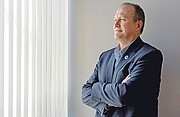AURORA
Associated Press
There was a time we would have marveled at flying to 380,000 feet to experience the curvature of the Earth, weightlessness, and the darkness of space.
In the next few decades, space travel may become so ordinary that we don’t even bat an eye. In Colorado that will be a reality thanks to Dave Ruppel, CEO of the newly-dubbed Spaceport Colorado.
“Our goal is to make this more commonplace,” Ruppel said from the Spaceport headquarters. Outside, planes from Denver International Airport, about five miles away, thundered overhead.
“That is reality in the future.”
Maybe not yet.
Ruppel, who calls himself a “space geek”, has taken the small Front Range Airport near Watkins on Aurora’s eastern edge through preliminary approval from the Federal Aviation Administration to become Colorado’s first hub for space tourism and the 11th in the nation.
In the next decade, the airport cum spaceport will count down to launching spacecrafts from the likes of Virgin Galactic, Airbus, and Reaction Engines to carry commuters and thrill seekers.
The FAA’s green light allows for ships that will takeoff like normal planes and fly east, away from the metroplex, but quickly climb to altitudes of 50,000 feet — about 14,000 feet higher than current commercial planes.
Then, planes engage rocket engines and soar as high as 380,000 feet, into the darkness.
At that point, passengers could begin to float out of their seats.
IT’S ROCKET SCIENCE
These hybrid-plane-rockets would not only fly high, but fast. A 17-hour flight to Tokyo could be reduced to 90 minutes when it’s all said and done — the time it takes to finish “Lost in Space”. Or, you could take the trip into the Earth’s orbit just for fun before dramatically re-entering the atmosphere.
The details are still up in the air as aerospace companies develop suborbital flight technology, although there are several prototypes and plenty of concepts for horizontal takeoff space-planes. UK-based Reaction Engines, which works out of a Castle Rock office for US operations, is already testing their technology at Spaceport Colorado.
Adam Dissel, president of Reaction Engines Inc, said the company put a couple of million dollars into a testing site on the edge of the airport for an air pre-cooler on a military jet engine. The goal is that the part would be on a Sabre engine that allows planes to move at rocket speeds. But because no aircraft can fly that fast yet, Dissel said, the company is recreating that scenario on the ground at Spaceport Colorado.
For right now, there’s no immediate change the spaceport designation will bring for Reaction Engines. But that could all change.
“In the further term, our technology would enable horizontal spacecraft to launch,” Dissel said.
Any prototype flying out of the spaceport would have to be approved by the FAA before taking off from Watkins. The industry is so emerging, that when the FAA conducted its environmental impact study before granting the spaceport’s license, authorities studied the impact of a hypothetical “objective space object”. There are no prototypes currently on the table. When an aircraft is chosen, the study will have to be adapted to that particular space-plane.
Rocket-like ships, such as the Blue Origin New Shepard, are off the table for now. That’s because of the potential for debris to fall from crafts and the sheer amount of energy required to vertically lift a sizable payload that would include space tourists.
Ruppel said the goal is to get everything squared away for the rocket-boosted planes.
SPACEPORTLANDIA
That’s a lot of potential for a small stretch of tarmac in rural Colorado.
The spaceport is also slated to boost Colorado’s growing aerospace industry — which is already a big contributor to the economy in Aurora and the metro region. There’s more than 400 aerospace firms in the state, according to data from the Colorado Office of Economic Development and International Trade. That equates to about 163,000 existing employees and a $3.2bn payroll, making Colorado the largest space economy in the US in 2013, according to the most recent statistics available.





Comments
Use the comment form below to begin a discussion about this content.
Sign in to comment
Or login with:
OpenID